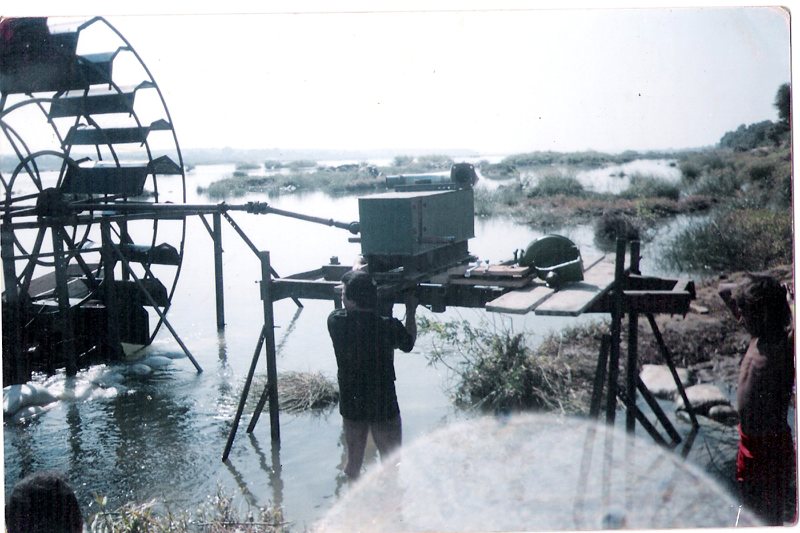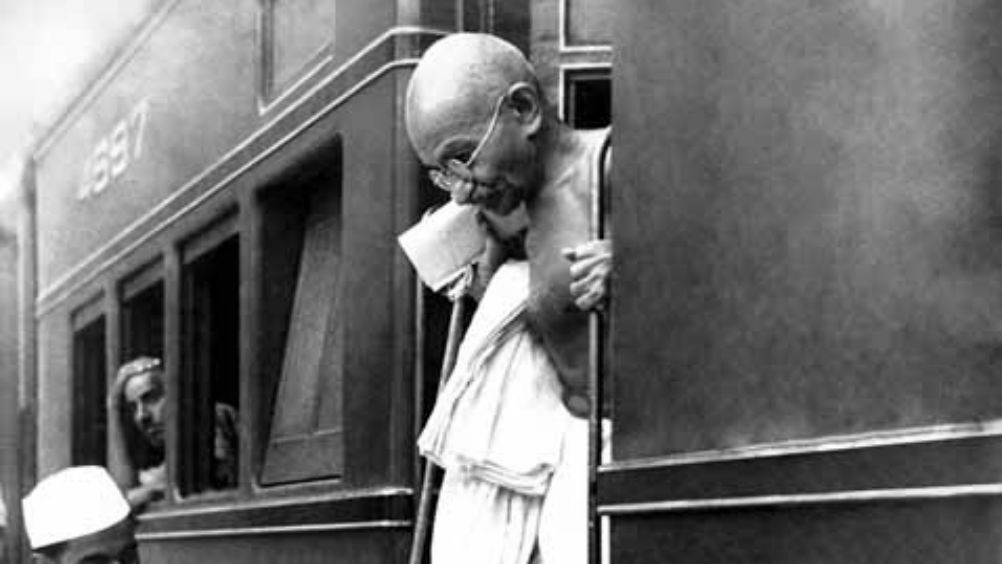Introduction
There are often too many hurdles in the path of rural innovators. No one knows it better than Mangal Singh, an innovator from Lalitpur district (Bundelkhand region) of Uttar Pradesh who has struggled relentlessly in very difficult conditions for nearly three decades.It was around 1987 that Mangal Singh had emerged as a star innovator with the successful demonstration in his village Bhailoni Lodh of Mangal turbine which lifts water from a river without using diesel or electricity. Senior officials, technocrats and researchers vied with each other to visit the village-site and showered well-deserved praise on the innovation as well as the farmer-scientist behind this (see box ‘What is Mangal Turbine’ and ‘Well-deserved praise’). A study by IIT Delhi and Vigyan Shiksha Kendra on the water resources of Bundelkhand found it very useful for quenching the thirst of land while also reducing the costs of farmers and helping villagers in cottage scale industries as well. Later other scholars presented impressive estimates of the reduction of GHG emissions possible by the use of Mangal Turbine in place of diesel pump sets. Despite obtaining a patent and a bagful of endorsements at a relatively early age, Mangal Singh and his innovation have been the object of apathy and even victimization in the three decades since then. Although he has continued his efforts to spread the word about his innovation, visiting several states in the country tirelessly, age and apathy have taken a toll on his health and spirits. Here is an excerpt from an interesting conversation with this inspiring but dejected innovator .
In order to help our readers make the most out of this interview, we present a brief yet detailed introduction to the Manual Turbine and its significance for Indian agriculture.
What is Mangal Turbine?
Mangal Singh is a farmer of Bundelkhand region who was known at a very young age for his enterprising and innovative farming methods. He used to see regularly that small farmers with low resources have a lot a difficulty in buying diesel for lifting water from streams and rivulets. He started thinking a lot about the possibilities of lifting water from small rivers, nullahs and canals without having to depend on diesel or electricity. After a lot of thinking and experimentation, he came up with a device which could lift water using the energy of flowing streams without depending on diesel or electricity.
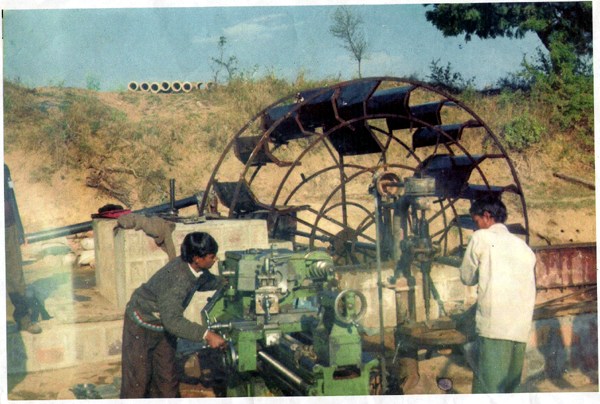
This invention was named Mangal Turbine. It was first demonstrated in 1987. Mangal Singh was 40 at that time. Later it was patented as “Mangal Water Wheel Turbine Machine” (Patent No. 177190 dated 13-11-1997) as per Government of India gazette Notification dated 30th November, 1998.
This technology is described by Mangal Singh in the following words, – “The water wheel turbine machine consists of a water wheel which is firmly mounted on a steel shaft and supports on two bearing blocks fixed on foundation supports. The shaft is coupled with a suitable gearbox through universal couplings for stepping up speed of rotation. Output shaft of the gear box is coupled on one end with a centrifugal pump for lifting water and the other end is mounted with a suitable pulley for deriving power for operating any machine. Design of the water wheel turbine is simple. It is available in different size to meet the varying requirements. Operation of water Wheel Turbine Pump-cum-P.T.O. Machine is very easy as anyone can operate the machine by opening the wooden or steel gate valve, the machine is stopped by stopping the flow of water through the gate.”
Thus apart from lifting water the Mangal turbine can also be used for several additional tasks. In the words of Mangal Singh, “This is used for pumping water from the rivulets and water streams on which it is installed. The machine can be used for several rural works such as operating atta chakki, sugarcane, crushing, threshing and winnowing, oil expelling, chaff cutting, etc. The machine provides a clean alternative (non-conventional) source of energy in remote rural areas for increasing agricultural productivity, income and employment”. By linking it to a generator, this machine can also provide electricity.
Well Deserved Praise
Several highly placed officials who examined Mangal Turbine carefully confirmed its great value and utility.At least two former Secretaries of the Rural Development Ministry (B.K. Sinha and S.R. Sankaran) were known to be admirers of Mangal Singh’s efforts. B.K. Sinha has spoken widely about the great usefulness of M.T. Others who have admired and appreciated the M.T. include the Alternate Hydro Energy Centre IIT Roorkee, The Energy Research Institute (TERI) New Delhi, Dr. Punjab Singh, former Director IARI Delhi, Senior bureaucrats like Shri Kalika Prasad the then Commissioner Jhansi, Dr. Sarla Gopalan former Advisor Planning Commission New Delhi and Dr. R.S. Tolia former Director State Institute of Rural Development-Delhi and MC CAPART, Central Zone Lucknow.
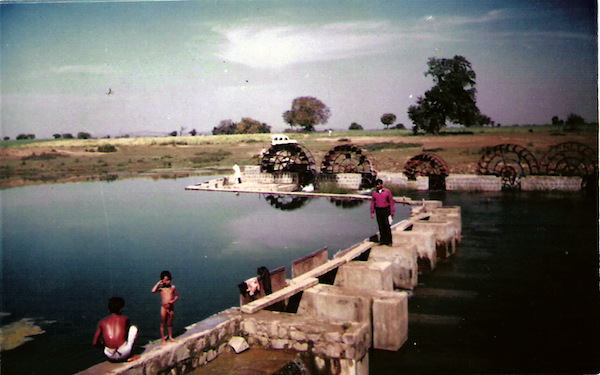
B.K. Saha, former Chief Secretary, Govt. of Madhya Pradesh, has written about this device, “I made a detailed analysis of the economic viability of the ‘Wheel’ and its comparative advantage vis-a-vis alternative methods of pumping water from streams and small rivers for irrigation. The system is extremely cost effective even after taking into consideration the cost of the Stop Dam. Where the Stop Dam is already available the system is even more cost effective. Installation of this device is strongly recommended wherever there is flowing water in small streams by constructing a stop dam and installing one or two water wheels as designed and developed by Shri Manga Singh. It saves on energy like electricity or diesel and is ecologically completely benign.”
Similarly Dr. T.P. Ojha former Deputy Director General (Engineering) of the Indian Council of Agricultural Research wrote that “Mangal Singh’s device offers great promise and possibility of lifting river water for irrigation, fisheries, forestry and drinking purposes. The water head created by putting a check dam across the river or perennial water course generates enough force to rotate the water wheels to operate one or two centrifugal pumps in series … The designer of the system Sh. Mangal Singh deserves appreciation and support to install few more units in different parts of the country for demonstration purposes.
The Maithani Report
About various harassments of Mangal Singh the Maithani Report says, “Shri Mangal Singh, who had been acclaimed as an inventor and innovator of rural technology was placed under FAS (further assistance stopped) category by CAPART in 1996 on a trivial issue of not submitting proper utilization report of the paltry sum of Rs. 6400/- released to him for a project in 1990. The DM Jhansi got his bank accounts seized in 1997 for allegedly not submitting the feasibility report of Mangal turbine along with the units supplied to Jhansi. Subsequently, the district administration Lalitpur also attached and auctioned his agricultural land allegedly for not completing the projects sanctioned by the DRDA.
In its more detailed examination of a project sanctioned by CAPART to Mangal Singh, the Maithani Committee has noted how time and again positive features of the work done under the project given to Mangal Singh were ignored and instead some flaw was always somehow found to unleash harassment. Again and again monitors and evaluators were sent, not to help Mangal Singh in better preparation of accounts but only to find some fault for which he could be harassed further. Even when the Director General sympathised with Mangal Singh and issued orders to stop this victimisation, the harassment still continued.
After examining all the evidence in great detail, the Maithani report concludes, “It will be clear from the above account that Shri Mangal Singh was harassed and harmed in the process of implementation of the project. This has happened not only in connection with the project under reference which was the last sanctioned by CAPART. It has happened in respect of all projects sanctioned by CAPART to Shri Mangal Singh earlier too.”
Further this report says, “There is no case against Shri Mangal Singh who needs to be compensated for the loses suffered due to advisory role played by CAPART in all the projects sanctioned to him simply because he did not ‘please’ them! Or because he was from humble background and rural area or because he was an anti-corruption activist.”
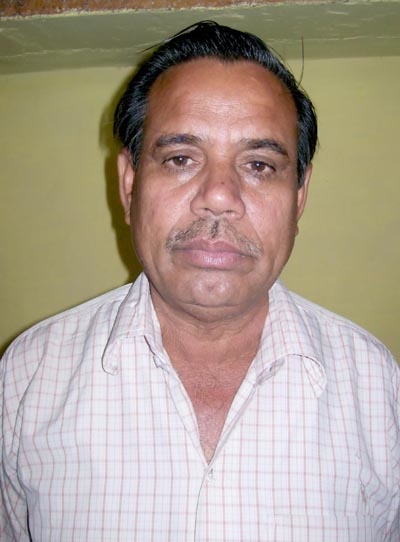
Here is the conversation
● Kindly tell us about your experiences after the successful demonstration of Mangal Turbine in 1987.
Initially several government and non-government organizations tried that I should work only or mainly for them but when I persisted in taking an independent stand they moved away from helping me. CAPART used to sanction very low amounts and when I somehow completed a lot of work sometimes using my own resources, they sent monitoring teams who were bent upon finding some accounting omission or the other. I told them I am an innovator not an accountant.
On the other hand some local influential people were upset with my sudden fame and tried to harm me. Organisations which had first wanted me to work for them only now tied up with these hostile people to snatch persons trained by me and damage my work. Pipes at my main work-site were broken. Work started at some sites had to be left mid-way. This reduced me to a situation where I had to knock on several doors for getting justice and this phase is still continuing.
● Did government agencies respond to your appeal for justice?
I made several appeals and several honorable members of Parliament also raised this issue. Finally the Secretary, Department of Rural Development appointed an expert Dr. B.P.Maithani to inquire into this issue and make recommendations. Dr. Maithani had retired as Director in the National Institute of Rural Development. With the co-operation of another member Dr. Maithani prepared a detailed report with the title ‘Evaluation Report on Fabrication and Popularisation of Mangal Turbine Project’. In brief this is often referred to as the Maithani Report. I obtained a copy of this report using the right to information. This report has clearly said that all charges againt Mangal Singh were unjustified and several officials acted in such ways as to harass him. (See box The Maithani Report). This report has also recommended that Mangal Turbine should be widely used and injustice done to me should be undone.
● Did the government initiate suitable action on the Maithani Report?
Its recommendations were distorted and I continued my efforts to get justice in courts of law. Several honorable members of Parliament have expressed support for me and have raised questions in Parliament regarding the injustice done to me. I find it really shocking that at a time when there is so much talk of reducing the costs of farmers and reducing greenhouse gas emissions , Mangal Turbine which is capable of reducing costs as well as emissions is still being neglected.
● What should the government do to popularize Mangal Turbine? What can be done to scale up your work so that more and more people can benefit from this?
The government should take effective steps as early as possible to give an important place to Mangal Turbine in its programs relating to irrigation, drinking water and renewable energy. This work should be started at several places at suitable sites so that the huge potential benefits to people as well as for environment protection can be realized without further delay.
Several lift irrigation projects in the country are non- functional today due to a number of reasons. Wherever suitable sites are available the Mangal Turbine can be used to give a new lease of life to these projects.
A small farmer-innovator can take forward such work only up to a limit on the basis of very limited resources available. It is for the government to scale-up this work and realize its benefits at a much wider level. Voluntary organizations can also make a contribution in this.
● You have devoted your entire life to Mangal Turbine. If the government wakes up belatedly to realizing the importance of spreading Mangal Turbine how can it obtain your co-operation in this effort?
Despite several problems and difficulties I have continued to take the message of Mangal Turbine to various parts of the country. From Rajasthan and Gujarat to Uttarakhand and Jammu and Kashmir, from Madhya Pradesh to W. Bengal I have been visiting so many places in this context without any resources and so I am familiar with several suitable sites.
Now if the government realizes the importance of this work then work can be started at several suitable sites. My services can be obtained for the overall guidance of this work and I can also train villagers particularly youths at these sites so that the new generation is also adequately informed about this. I am over 70 now and constant tensions and wanderings have taken their toll. In my student days I used to be called Tarzan due to my strong physique and good health, but in recent years my health has been deteriorating. Therefore there should be no further delay in utilization of my services in the larger national interest and for the benefit of people and environment protection. Along this the many-sided injustice done to me should also be effectively tackled and adequate compensation should be provided to me. The recommendations of the Maithani Committee should be implemented in the right spirit.
Bharat Dogra is a freelance journalist who has been involved with several social movements and initiatives. His recent book on survival issues and people’s response titled Planet in Peril has been published by Vitasta, Delhi.

